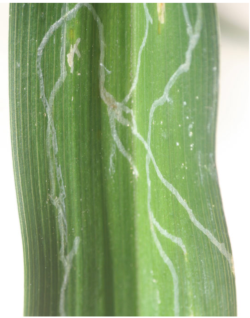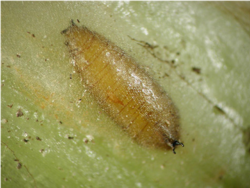INSECT HOT TOPICS: Daylily leafminers
by James A. Bethke
The Society of American Florists’ Pest and Production Management Conference began as the Leafminer Conference back in 1980. The Leafminer Conference was all about one agromyzid leafmining fly, Liriomyza trifolii (Diptera: Agromyzidae), which was causing havoc on a wide variety of vegetables and ornamental plants nationwide. The seriousness of the issue caused a decade of frantic research on the biology and control of this species, and it also caused many growers to go out of business or change what they were growing.
There is a new looming threat, the daylily leafminer, Ophiomyia kwansonis Sasakawa (Diptera: Agromyzidae), that is plaguing Hemerocallis species in landscapes and ornamental production across the country. Fortunately, if there is one saving grace, it is that it is host specific. It originates from Japan and Taiwan, and it was first noticed on daylilies in the United States in 2006 in Maine (see bugguide.net link below). Soon afterward, it was observed widespread as people took note. As of January, 2014, it has been officially detected in Alabama, Arkansas, Connecticut, Delaware, Florida, Georgia, Illinois, Indiana, Kentucky, Louisiana, Maine, Maryland, Massachusetts, Mississippi, Missouri, New Hampshire, New York, North Carolina, Ohio, Oklahoma, Pennsylvania, South Carolina, Tennessee, Texas, Virginia and West Virginia. The likelihood of detection in California is high, so be on the lookout.

As with the serpentine leafminer, control of the daylily leafminer is difficult, and colleagues across the country are seeking answers. It is obviously more difficult to manage in the landscape than in production due to the greater number of chemical control options in production. Due to the fact that they pupate in the leaves, removal of older infested leaves will likely reduce populations. As with other Liriomyza species, native parasitoids may attack the daylily leafminer, but none have been recorded so far.

Gaye Williams, an entomologist from the Maryland Department of Agriculture, is conducting a national survey for this pest and would love to see any photos of suspected day lily leafminer. Email your photos to Gaye Williams (Gaye.Williams@maryland.gov).
Web pages of interest with lots of interesting photos:
http://bugguide.net/node/view/655288
http://freshfromflorida.s3.amazonaws.com/ophiomyia-kwansonis.pdf
http://entnemdept.ifas.ufl.edu/hodges/ProtectUs/presentations/Exotic_Pests_Ornamental_Plants.pdf
http://www.daylilies.org/ahs_dictionary/leafminer.html
http://www.amerinursery.com/article-7705.aspx
http://citybugs.tamu.edu/2013/05/22/new-pest-of-lilies-in-texas/
http://entnemdept.ufl.edu/hodges/september_2011.pdf
http://citybugs.tamu.edu/tag/ophiomyia-kwansonis/
http://ecoipm.com/research/daylily-leafminers/
http://blogs.mcall.com/master_gardeners/2013/05/watch-out-for-daylily-leafminer.html
http://mypestprevention.com/2013/05/daylily-leafminer/
http://www.ldaf.state.la.us/wp-content/uploads/2014/08/Daylily-Leafminer-Profile.pdf
https://www.eppo.int/QUARANTINE/Alert_List/insects/ophiomyia_kwansonis.htm
http://www.fera.defra.gov.uk/plants/plantHealth/pestsDiseases/documents/ophiomyia.pdf
James Bethke is Farm Advisor for Nurseries and Floriculture, UC Cooperative Extension, San Diego and Riverside Counties.












